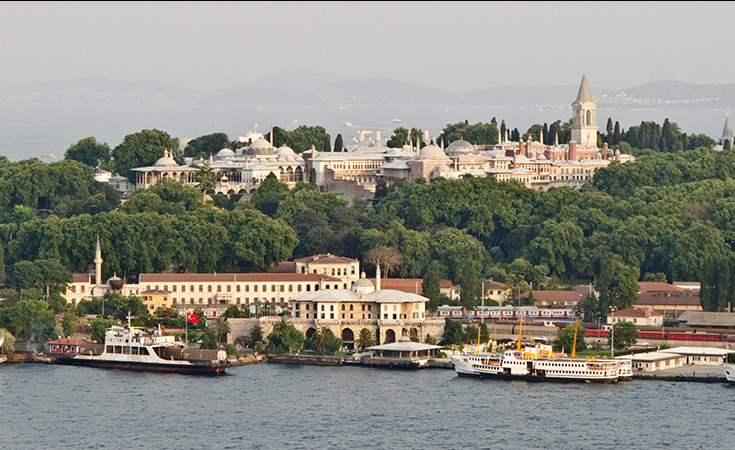
The magnificent Topkapi Palace or Cannon Gate Palace is considered one of the most important landmarks of Istanbul, as well as the largest museum in Turkey. A place where sultans, servants, concubines and sages lived. This was the seat of the Ottoman rulers for 400 years, and official records testify that 4,000 souls lived in the palace.
Large ramparts hide landscaped gardens and castles on an area of 700,000 m2. Mehmed II the Conqueror built the palace after conquering Istanbul. Topkapi Palace was the main palace until the construction of perhaps the most beautiful palace today, Dolmabahçe on the Bosphorus. Although the new palace took over many functions, Topkapi retained more important functions such as the imperial treasuries, mosque, mints, etc.
Topkapi Palace represents the core of the history of the Ottoman Empire. It contains various historical documents as well as the most famous diamond in the world - the Kasikci diamond - it has a total of 86 carats and is decorated with 49 diamonds. The palace is the place where state affairs were conducted, important decisions were made, but also the place where the sultan's harem was located and where lavish parties were held. This very rich palace causes many sighs of visitors every day. With its appearance and rich history, it attracts tourists from various parts of the world, and it is often one of the main reasons why tourists decide to visit Istanbul.
Today, Topkapi Palace ranks among the museums with the richest works of art, exhibits, tools and weapons. In 1924, it officially became the Imperial Museum and is managed by the Ministry of Culture and Tourism.
A walk through Topkapi Palace takes a long time, researching history turns into an adventure at this place. You can also see carriages and horses passing through the palace gardens of which there are 4 in total, which gives an added feeling of stepping back in time. Although the palace itself has a large number of important rooms, not all of them are open to the public.
There are 4 gates leading to the courtyard, the Imperial Gate, the Gate of Salutation, the Gate of Chastity leading to the Harem and the fourth gate offers a beautiful view of the Bosphorus and is the part that the Sultan used during the day as a living room. The palace is divided into 4 courts. Janjicar's court was intended for an office, the other door leads to the imperial hall and the treasury where the Sultan's cabinet named Divan was located. The Kasakci diamond is located in this part. The Gate of Chastity leads to the Harem, and this court is the most frequented. It is especially interesting to discover the love life of the sultans, who could officially have 4 wives. The fourth court was used for the sultan's daily rest, it had a large fireplace decorated with decorations from the 17th century and a magnificent terrace.
Also, one of the characteristics of Topkapi Palace are tulips. Just as the Blue Mosque has tiles on which tulips are painted, Topkapi Palace also has tulips, which are one of the symbols of this city and its history. Sultan Ahmet III was a big fan of tulips, so they are spread all over the courtyard of Topkapi Palace.
The story of the Kasikci diamond
In 1669, a fisherman passing by the garbage dump of the Porphyrogenitus Palace in Istanbul came across something unusual, it looked like a shiny stone. The fisherman put the jewel in his pocket, where it remained for the next few days until the fisherman found himself in the market next to the goldsmiths' shops.
He showed the diamond to the first jeweler he came across. The goldsmith immediately recognized the true value of the stone. The jeweler said to the fisherman: "It is a piece of glass, take it and carry it or if you like it I will give you three spoons for whatever you have for your labor. The fisherman accepted his offer as a fair price and went away satisfied with his three spoons, and the goldsmith received the fourth largest diamond in the world.
Another version of the diamond legend in which a French officer named Pigot bought a diamond in India from the Maharajah of Madras in 1774. Years later, the gem was put up for auction in Paris, where it was bought by Napoleon's mother, Marie Letizia Bonaparte.
After Napoleon was exiled, the diamond was put up for sale to finance the ex-emperor's rescue. The man who eventually bought it was a prominent Turk. In this way, the diamond returned to Constantinople, where it was found. When the Turk was executed by Sultan Mehmet II on suspicion of treason, all his wealth was confiscated by the Sultan and ended up in the Ottoman treasury.
The next appearance of the diamond is during the reign of Sultan Mehmet IV, around 1800. It is most likely that the diamond belonged to a Roman ruler, that is, the ruler of the Eastern Roman Empire, given that it was found in Porphyrogenitus' palace.
Author of the text:

Maja Glavaš, Bachelor with Honours in Communicology. Works in Tourism.
Contact: [email protected]; instagram: travel_europe1
Photo by Nima Aksoy on Unsplash